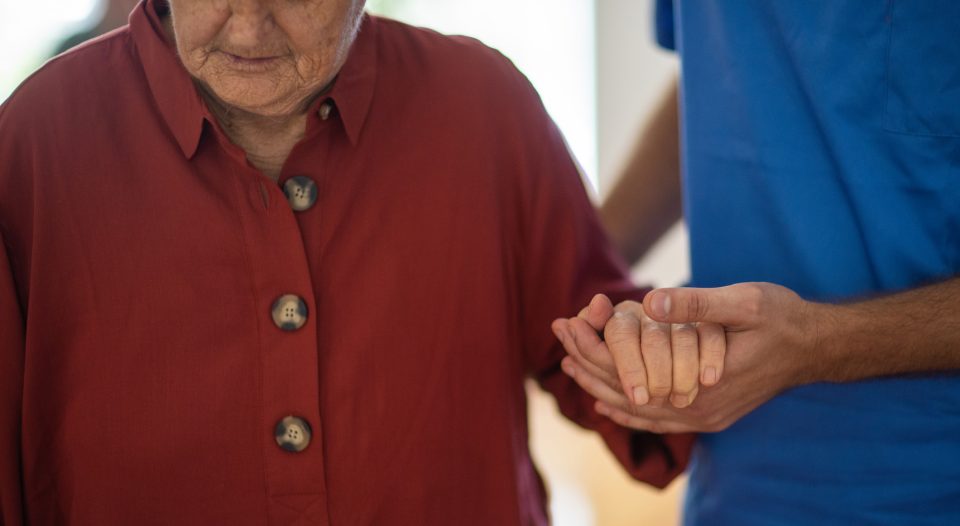About five years ago, I was asked to help people at our small Lutheran church manage the steps to the altar rail for communion. There are only two steps, but for a dozen or so people in our aging congregation, two steps have become a lot. Though people can receive the sacrament in their pew, most folks are determined to get to the Lord’s table.
Back then I didn’t know how much this little bit of helping would mean.
I had been “volunteered” for the job when the previous assistant started working out of town and couldn’t attend services regularly. Though I knew there were few able-bodied candidates, I was still reluctant to say yes. At age 60, I was developing my own minor mobility issues. But the bigger worry was emotional. I don’t take communion myself. The child of a Lutheran mother and Jewish-atheist father, I’m late to Christian faith and unbaptized. No one in our church makes me feel weird about this, but I didn’t relish the idea that my nonparticipation would be on display up front during communion.
No matter the level of assistance, these brief weekly encounters have become sort of a ritual for me, opening up another way of knowing my churchmates and the practice of faith.
Five years ago, the only person who consistently needed help up the steps was a diminutive 95-year-old I’ll call Ida. She had become so unsteady that I helped her all the way to the communion rail and kept a hand on her back as she stood, waiting. After receiving the bread and wine, she’d give me her little glass because she needed one hand on her cane and the other on my arm for the slow trip back to her pew. I remember that first time—I accidentally touched a bit of wine as I took her glass and worried that it might be some small transgression. Soon enough I got used to what I thought were “inappropriate” moments, which I later realized didn’t matter, except maybe positively.
No one else has needed as much help as Ida. Some need very little—a touch beneath their elbow, a hand to help with balance while coming down the steps. Others have needed help while healing from surgery or a fall. No matter the level of assistance, these brief weekly encounters have become sort of a ritual for me, opening up another way of knowing my churchmates and the practice of faith.
People have distinct approaches to the challenge of the steps. A quiet woman I don’t know well puts out her right hand with her fingers together as I help her up, the way a lady might when a courtier assists her into a carriage. A long-retired obstetrical nurse who had a hip replacement grabs my hand with arresting strength as she descends. An older couple, coming slowly from the last pew, needs help ascending and descending. Ascending, the woman looks me in the eye, smiles in a lovely way and thanks me by name; descending, the man says, out of the corner of his mouth, “You’re a good man, Ben,” and I tell him it’s an honor.
These weekly moments at the steps are nothing momentous. But in their physical intimacy and spirit, they have become part of how I understand and feel devotion.
Whispered exchanges happen with a number of folks, mostly men, and these are often lighthearted bits of unsacred behavior. I have a running gag with a former salesman who works his eyebrows in mock alarm as he approaches the steps. After church he’ll accuse me of rank incompetence. “Did you see him?” he’ll say to a crony. “I take my life in my hands.” I reply, “Only for you.” I’m not sure Jesus had any of this in mind at the Last Supper. On the other hand, he did know all about people being people, needing what we need.
Let me not romanticize. Most of the people I help are in some version of pain. Their struggles and their stoicism reveal the merciless force of aging. Little Ida, whom I stood with at the rail, is now three years gone. After her last church service, on Christmas Eve, my son and I helped her from the sanctuary, still bright with voices and light, and drove her through the dark to the local nursing home—passing, as it happened, the house where she had once lived, unmarried and independent, all her life. She turned from the window and buried her face.
These weekly moments at the steps are nothing momentous. But in their physical intimacy and spirit, they have become part of how I understand and feel devotion. This became clearer to me about a year ago, when I was sick at home and watched the service via livestream. My substitute at the altar steps that day did his best, but he didn’t know the little particularities of each person. Worse yet, there were people I always help whom he didn’t know to help at all! After one and then another took the steps unaided, I realized that some of my churchmates accepted my help because they sensed I needed to give it.
Irish poet and theologian Pádraig Ó Tuama says, “If there’s a hundred people who come to church service every week, there might be a hundred different reasons why they’re there.Some people like the sound of the singing and that’s enough, some people like the touch of a hand when you shake hands during the time of peace. That’s enough.” My partners at the altar steps have certainly helped me find the deep, faithful sufficiency of touch.





